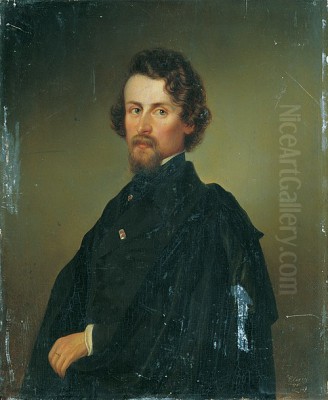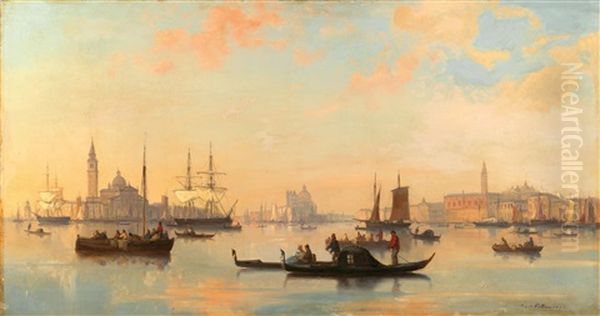
Josef Karl Berthold Puettner (1821-1881) stands as a notable figure in 19th-century Austrian art, celebrated primarily for his evocative marine paintings and detailed landscapes. Born in the imperial capital of Vienna, Puettner's life and career unfolded during a period of significant artistic transition, bridging the gap between the late Romantic era and the rise of Realism. His dedication to capturing the essence of nature, particularly the dynamic power of the sea and the specific character of places he visited, earned him recognition within the vibrant Viennese art scene and beyond.
Puettner's artistic journey appears to have gained public visibility early on. Records indicate that he began participating regularly in the exhibitions held at the prestigious Vienna Academy of Fine Arts starting in 1842. This suggests an early commitment to his craft and an engagement with the established art institutions of his time. While specific details about his formal training or particular mentors remain elusive in readily available sources, his participation in these exhibitions points towards a connection, whether as a student or an independent artist seeking recognition, with the academic art world of Vienna.
The Influence of Travel
A pivotal period in Puettner's artistic development occurred between 1846 and 1847 when he embarked on extensive travels. This journey, reminiscent of the Grand Tour tradition favoured by artists for centuries, took him to key artistic centres and inspiring natural locations. He spent time in Rome and Venice, immersing himself in the rich cultural heritage and picturesque scenery of Italy. His travels also extended to the Netherlands, a country with a long and distinguished tradition of landscape and marine painting, and to various unnamed "island countries," which likely included destinations known for their dramatic coastlines or maritime activity, possibly islands like Heligoland, Capri, or others in the Mediterranean or North Sea.

These travels profoundly shaped Puettner's artistic vision and subject matter. The experience of different landscapes, architectural styles, and atmospheric conditions provided a wealth of inspiration. Upon returning to Vienna, he translated these experiences into numerous paintings. His time in Italy, particularly Venice, seems to have left a lasting impression, as evidenced by one of his most recognized works. The Netherlands, with its canals, harbours, and maritime history, would have offered distinct motifs compared to the sun-drenched vistas of Italy.
Master of Marine Painting
While accomplished in landscape painting generally, Puettner carved a particular niche for himself as a marine painter. This genre focuses on the sea, often featuring ships, coastal views, and the atmospheric effects associated with maritime environments. Austrian artists were not as predominantly associated with marine painting as their Dutch, English, or Scandinavian counterparts, making Puettner's focus somewhat distinctive within his national context. His works likely captured the diverse moods of the sea, from tranquil harbours under clear skies to dramatic storms battering coastlines or challenging vessels.
His marine paintings would have demanded careful observation of wave patterns, the effects of light on water, cloud formations, and the accurate rendering of ships, whether traditional sailing vessels or the increasingly common steamships of the era. The appeal of marine painting lay in its ability to convey nature's power, the spirit of adventure and exploration, and the vital role of maritime trade and travel in the 19th century. Puettner contributed to this genre with a distinctly Austrian perspective, informed by his travels and observations.
Landscapes of Italy and Beyond
Puettner's skills extended beyond purely marine subjects to encompass broader landscape views. His travels provided ample material for depicting the urban landscapes of Venice and Rome, the pastoral scenery of the Italian countryside, or the characteristic flatlands and waterways of the Netherlands. His Austrian roots may also have led him to depict scenes closer to home, although his reputation seems more strongly tied to the subjects gathered during his travels.
His landscape style likely blended elements of Romanticism, with its emphasis on atmosphere and emotion, and the growing trend towards Realism, which valued accurate depiction and observation from nature. He is noted for capturing specific locations, such as views featuring the iconic Basilica di Santa Maria della Salute or the church of San Giorgio Maggiore in Venice. This suggests an interest in topographical accuracy combined with an artistic interpretation of place. The inclusion of "high trees" mentioned in some descriptions might point towards a Romantic sensibility for the grandeur of nature.
Notable Works and Artistic Style
Among Puettner's most significant works is the "Panoramic Painting of Venice." This piece, specifically noted as depicting the Grand Canal with the Basilica di Santa Maria della Salute, showcases his ability to handle complex cityscapes and water views on potentially a large scale. Panoramas were popular in the 19th century, offering immersive views of famous locations. Puettner's panorama would have captured the unique interplay of architecture, water, and light that defines Venice, demonstrating his skill in composition, perspective, and rendering detail.
His overall style can be situated within the mid-19th century European mainstream. It likely involved competent draughtsmanship, a sensitivity to light and atmosphere, and a colour palette appropriate to his subjects – blues, greys, and greens for marine scenes, warmer tones for Italian landscapes. The brushwork might have varied from detailed rendering in foreground elements and specific structures to broader strokes for skies and water, aiming for both accuracy and evocative effect. He worked primarily in oil on canvas, the standard medium for ambitious landscape and marine paintings of the period.
Professional Recognition and Later Life
Puettner's career was marked by consistent professional engagement. His regular participation in Vienna Academy exhibitions from 1842 onwards provided visibility. A significant milestone was his acceptance into the Vienna Künstlerhaus (Society of Austrian Artists) in 1861. Membership in this prestigious association signified recognition by his peers and cemented his status within the Austrian art establishment. The Künstlerhaus served as a vital hub for artists, facilitating exhibitions, discussions, and professional networking.
In 1869, Puettner relocated from Vienna to Bad Vöslau, a spa town situated south of the capital. The reasons for this move are not explicitly documented but could relate to health, a desire for a quieter environment, or proximity to different landscape motifs in the Vienna Woods region. He continued to work from Bad Vöslau until his death in 1881. His life spanned a dynamic period in Austrian history and art, witnessing the flourishing of the Biedermeier era, the revolutions of 1848, and the establishment of the Austro-Hungarian Empire.
Puettner in the Context of 19th-Century Austrian Art
Josef Karl Berthold Puettner worked during a vibrant era for Austrian art. The earlier part of his career overlapped with the Biedermeier period, known for its intimate portraits, genre scenes, and detailed landscapes, often imbued with a sense of comfortable domesticity or local pride. Artists like Ferdinand Georg Waldmüller (1793-1865), a leading figure known for his realistic depictions and brilliant use of light, set a high standard for observational painting. The tradition of detailed landscape and topographical views was also strong, exemplified by the meticulous watercolours and oils of Rudolf von Alt (1812-1905).
Romanticism also held sway, particularly in landscape painting, with artists like Friedrich Gauermann (1807-1862) capturing the dramatic beauty of the Austrian Alps, often including animals. While Puettner focused more on marine and international scenes, the underlying Romantic sensibility for nature's power and atmosphere likely informed his work. As the century progressed, Realism gained ground, influencing artists to depict the world with greater objectivity, a trend visible across Europe.
Contemporaries Across Borders
Puettner's work, especially his marine paintings, can be viewed alongside developments in other European countries. The Düsseldorf school of painting in Germany was particularly strong in landscape and marine art. Andreas Achenbach (1815-1910) was renowned for his dramatic seascapes, often depicting storms and shipwrecks with great technical skill. His brother, Oswald Achenbach (1827-1905), specialized in colourful, atmospheric views of Italy, sharing Puettner's interest in Italian subjects.
Other relevant landscape painters active during Puettner's time include the German artist Eduard Schleich the Elder (1812-1874), known for his atmospheric landscapes, often depicting the Bavarian plains. In Norway, Hans Gude (1825-1903) was a leading landscape and marine painter who taught for many years in Germany and influenced numerous artists. Further afield, the French Barbizon School painters, such as Théodore Rousseau (1812-1867) and Jean-Baptiste-Camille Corot (1796-1875), were revolutionizing landscape painting with their emphasis on open-air observation and capturing fleeting effects of light, though their direct influence on Puettner is uncertain. Within Austria itself, later landscape painters like Emil Jakob Schindler (1842-1892), known for his atmospheric "mood Impressionism," emerged towards the end of Puettner's life. Other German contemporaries exploring landscape included Carl Morgenstern (1811-1893) and Johann Wilhelm Schirmer (1807-1863). While Puettner was part of this broad European movement, his specific contribution lies in his focus on marine subjects and his depictions of the locations he visited during his formative travels.
Legacy and Conclusion
Josef Karl Berthold Puettner died in 1881 in Bad Vöslau. While perhaps not achieving the same level of international fame as some of his contemporaries, he remains a respected figure within Austrian art history. He was a dedicated professional artist who actively participated in the Viennese art world through exhibitions and membership in the Künstlerhaus. His legacy rests on his skillful contributions to marine and landscape painting.
His travels provided him with a distinct repertoire of subjects, particularly his Venetian and maritime scenes. He successfully navigated the stylistic currents of his time, blending Romantic sensibilities with the detailed observation associated with Realism. His works serve as valuable documents of the places he depicted and as examples of the high standard of landscape and marine painting achieved in Austria during the mid-19th century. Puettner's paintings continue to be appreciated for their technical competence, atmospheric quality, and their engaging portrayal of the sea and scenic locations across Europe. He represents an important strand in the rich tapestry of 19th-century Austrian art.